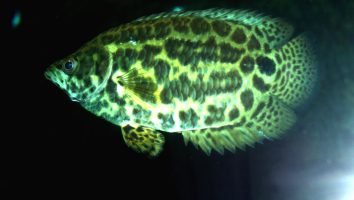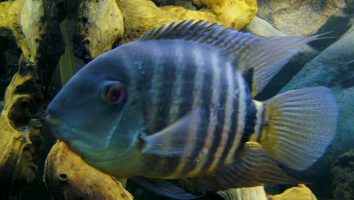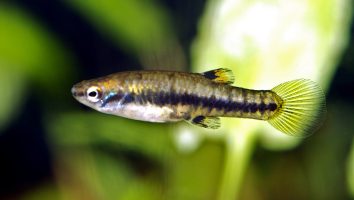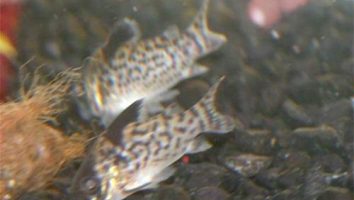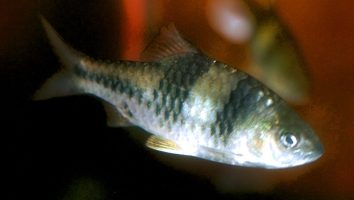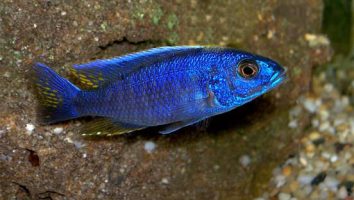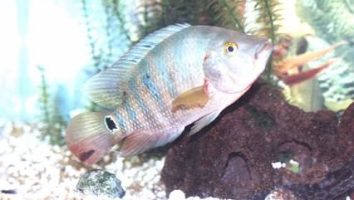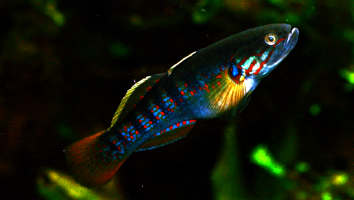The tire track eel is a beautiful and unique freshwater fish that is perfect for the beginner aquarist. They are hardy and can tolerate a wide range of water conditions, making them a great choice for those just starting out.
This guide will teach you everything you need to know about tire track eel care. You’ll learn about their diet, size, lifespan, and more!
Table of contents
Species overview
Tire track eels (Mastacembelus armatus) are found throughout a large portion of Southeast Asia. Their habitats include countries like Thailand, Laos, Cambodia, and Vietnam.
They prefer slow-moving waters with a lot of vegetation and hiding places. This is something that’s not too difficult to replicate in most aquariums.
Tire track eels are nocturnal predators that primarily eat small fish, invertebrates, and even smaller eels. In the wild, they have been known to grow up to 3 feet long but in captivity, they usually max out at around 2 feet.
One of the most notable things about this fish is the black and white stripes that run down the length of their body. This is how they got their name and it’s something that really makes them stand out in the aquarium world.
Appearance

The Tire Track Eel is a very interesting-looking creature. As you can probably guess from their name, they have a tire-track pattern that goes down the length of their bodies.
This pattern is made up of two dark lines that start at the eel’s head and run all the way down to the tip of their tail. In between these lines is a lighter color that can be anything from white to yellow.
The Tire Track Eel’s body is long and slender with a snake-like appearance. They have a small head with two beady eyes that sit on the sides of their head.
They have a small mouth that is filled with sharp teeth that they use to tear their food apart.
The Tire Track Eel’s fins are small and inconspicuous. They have a small dorsal fin that is located towards the back of their body.
They also have a small anal fin and a very small caudal fin.
The Tire Track Eel’s skin is smooth and slimy. They secrete a slime that helps them to move through the water and also protects them from parasites and diseases.
Lifespan
Tire track eels have a lifespan of 5 to 10 years. The lifespan of a tire track eel can be greatly impacted by the quality of care it receives.
Poor water quality, for example, can shorten the lifespan of a tire track eel significantly.
Size
These eels can grow to be about 2-3 feet in length, but are typically only about 1-2 feet long in captivity.
Tank
Tank Size
The recommended minimum tank size for a tire track eel is 30 gallons. If you have a smaller tank you might be able to get away with a 20 gallon tank but we don’t recommend it.
The main reason why you need a larger tank is because these fish grow to be quite large. They can reach up to 3 feet in length so you need to make sure you have enough space for them to comfortably swim around.
Another reason why a larger tank is better is because it provides more stability. A smaller tank is more likely to fluctuate in temperature and water quality which can be stressful for your fish.
Water Parameters
The tire track eel is a freshwater fish that is native to Southeast Asia. They are found in Thailand, Laos, Cambodia, and Vietnam.
The tire track eel prefers to live in slow-moving waters with plenty of hiding places. They are often found in canals, ditches, and ponds.
In the wild, the tire track eel’s diet consists of small crustaceans, insects, and worms.
In captivity, the tire track eel is a peaceful fish that does well with other peaceful fish. They can be shy at first, but they will eventually come out and explore their new home.
The tire track eel is a nocturnal fish, so they are most active at night.
The tire track eel prefers a water temperature of 75 to 82 degrees Fahrenheit. The pH should be between 6.5 and 7.5. The water hardness should be between 5 and 15 dGH.
What To Put In Their Tank
When it comes to the inside of their tank, you have a few different options.
You can go the natural route and try to recreate their native habitat as best you can. This would involve a lot of plants, driftwood, and rocks.
You could also go for a more minimalist approach and have a bare bottom tank. This is the route we recommend since it’s easier to clean and these fish are burrowers.
If you do go with a bare bottom tank we recommend using a dark substrate. This will help to make your Tire Track Eel feel more secure since they’ll be able to see their reflection. It will also help to make them stand out a bit more (they’re not the most colorful fish).
As for decorations, a few pieces of driftwood or some rocks should be fine. Avoid anything too big or sharp since they might burrow underneath it and get stuck.
Common Diseases
The tire track eel is a hardy fish that is relatively resistant to disease. However, that doesn’t mean that they’re immune to everything.
There are a few things that you need to watch out for when keeping tire track eels. The most common ailment that these fish experience is hole-in-the-head disease.
This is a condition that is caused by poor water quality and the presence of activated carbon in the tank. It presents itself as one or two pits/holes in the skin of your eel’s head.
While it’s almost always curable (fixing your water quality and removing activated carbon is usually all you need to do), it will usually leave some scarring on your poor eel!
The other disease you need to be aware of is ich. This is a very common freshwater disease that can affect any fish, no matter the species.
It manifests itself as white spots on the body, fish, and gills of your fish. If you notice this, it’s important to act fast and begin treatment immediately.
The best way to prevent these diseases is, as always, by maintaining a clean and stable tank. If you provide your tire track eel with good living conditions, they will be much less likely to fall ill.
Behavior & Temperament
The tire track eel is a nocturnal creature, so don’t expect to see much activity during the day. These fish are most active at night when they come out to scavenge for food.
During the day, they like to stay hidden in the dark recesses of their tanks. This can make them seem a bit shy, but they’re really just trying to stay out of the light.
The tire track eel is a peaceful creature that is typically gentle with others, unless it feels threatened. If it does feel threatened, it will try to escape first. If that’s not possible, it will use its sharp teeth to defend itself.
Overall, the tire track eel is a relatively low-maintenance fish that is easy to care for. As long as you provide it with a hiding place and plenty of food, it will be happy in its new home.
Tank Mates
Tire track eels are a predatory species, which means they will eat anything they can fit in their mouth. This includes other fish, inverts, and even smaller eels.
Due to their nocturnal habits, they’re also known to eat fish that are sleeping. For this reason, it’s important to choose tank mates that are too large to be eaten and/or are fast enough to get away.
With that in mind, here are some compatible tank mates for tire track eels:
- Arrowana
- Arowana
- Oscar
- Convict Cichlid
- Jack Dempsey
- Green Terror
- Firemouth Cichlid
- Texas Cichlid
- Plecostomus
Breeding
Breeding tire track eels is not for the faint of heart. These fish are difficult to keep, let alone breed. If you’re up for the challenge, though, the process can be rewarding.
First, you’ll need to set up a breeding tank. It should be at least 50 gallons and filled with soft, sandy substrate. The water should be clean and well-filtered. Keep the temperature between 78 and 82 degrees Fahrenheit.
Next, add some hiding places. These eels like to burrow, so provide them with plenty of places to do so. Driftwood, rocks, and caves will all work.
Now you’ll need to add the eels. Start with one male and two females. The male will be the larger of the three.
As with most fish, the key to successful breeding is to make sure the eels are well-fed. They should be eating a varied diet of live, frozen, and pellets.
Once the eels are comfortable and well-fed, the female will lay her eggs. The male will then fertilize them.
Eggs will be laid in a hidden area, usually under a rock or in a cave. The male will guard them until they hatch.
The eggs will take about two weeks to hatch. Once they do, the fry will be on their own. They’ll need to find food in the form of small invertebrates.
Tire track eel breeding is not for the casual hobbyist. These fish are difficult to care for and even more difficult to breed. But if you’re up for the challenge, the process can be rewarding.
Conclusion
The Tire Track Eel is an excellent beginner eel for the home aquarium. They’re relatively small, peaceful, and easy to care for.
Even though they’re easy to care for, it’s important to do your research before bringing one home.
Make sure you have a proper setup and that you understand their diet and care requirements. If you do your homework, you’ll be rewarded with a happy and healthy eel that will bring a lot of joy to your life!

